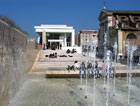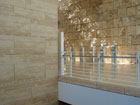
Designed by Richard Meier & Partners, LLC, the
Museo dell’Ara Pacis in Rome, Italy, was recently acknowledged with a Marble
Architectural Award for its outstanding use of stone. The facility makes
extensive use of Roman travertine, which was quarried and processed by Mariotti
Carlo & Figli of Tivoli, Italy.
Located on the banks of the Tiber River in Rome, Italy, the Museo dell’Ara Pacis was designed as a renewed setting for the Ara Pacis (Altar of Peace), a sacrificial altar dating to 9 B.C. Several years ago, it was decided that the facility housing the altar was not properly equipped to ensure its long-term conservation and that a new museum complex needed to be built in accordance with the most up-to-date conservation criteria. The resulting museum space, which was designed by Richard Meier & Partners, LLP, utilizes Roman travertine as a primary building element.
Recently, the design of the Museo dell’Ara Pacis was honored with a special mention as part of the 25th Marble Architectural Awards (MAA), which were presented at the CarraraMarmotec event in Carrara, Italy. Although the MAA typically focuses on a specific region, the “silver edition” of the program opened the competition to include projects completed anywhere in the world with any marble, granite or other stone materials from anywhere and processed anywhere across the globe.

For Meier, the use of Roman travertine at the Museo
dell’Ara Pacis was a return to the material he specified for the world-renowned
J. Paul Getty Center in Los Angeles. The architect was personally involved in
devising the “guillotines” that are used to split the material and give the
stone its unique appearance.
“Planned as part of an effort to protect Rome’s cultural legacy, the new structure replaces the monument’s previous enclosure, which was in a state of advanced decay,” reads a statement from Richard Meier & Partners. “The structure consists of a long single-story glazed loggia elevated above a shallow podium providing a transparent barrier between the embankment of the Tiber and the existing circular perimeter of the mausoleum of Augustus, built circa 28 B.C.
“The altar was relocated from the Campo Marzio in 1938 during the Mussolini era, and a system of regulating lines was applied to the project to relate the altar’s present position to its original site,” the statement continues. “Bisecting the distance between the present center of the mausoleum and the original site yielded a four-square urban grid that was used as a proportional frame to reorganize the piazza and its surroundings. An artificial obelisk is used as a historical reference on the north-south axis through the altar. The clarity of the volumes and the building’s proportions relate in scale to Rome’s ancient structures. A predominating feature of the new building is a glass curtain wall measuring 150 feet long and 40 feet high.”

The travertine was used for a range of applications
throughout the museum.
From the very beginning, the design of the Museo dell’Ara Pacis was to include premium building products, including natural stone. “The design of the new museum is of the highest quality, as are the first-class materials that were used to build it,” according to a statement released by the museum. “The materials were chosen with a view to integrating the building with its surroundings: the travertine gives continuity in the color scheme, the plaster and glass, which create a two-way transition between the interior and exterior and give a contemporary effect of volume and transparency, simultaneously full and empty.”
The travertine was quarried and processed by Mariotti Carlo & Figli of Tivoli, Italy, which also supplied the material used for the Getty Center. In fact, Meier was personally involved in devising the “guillotines” that are used to split the material and give the stone its unique appearance. “It has been worked in a ‘cracked’ fashion, which - in conjunction with the characteristics of the stone itself - make it a unique material,” according to the museum’s statement. “The technique that produced it was honed by Meier himself.”
The travertine not only fits in with the overall design goals, but it also provides a connection between different spaces and between the museum and the natural surrounding environment. “Outside the main structure, a low travertine wall extending from within the main hall traces the ancient shore of the Tiber River,” reads a statement from Richard Meier & Partners. The stone wall continues into the museum and serves as a backdrop for works such as modern plaster casts of Julio-Claudian Roman portraits.
In addition to housing and protecting the Ara Pacis, the facility also hosts temporary exhibitions and installations dedicated to archaeological themes and a state-of-the-art digital library of Augustan culture. The building also features an outdoor roof terrace that includes a bar and café with views over the Mausoleum of Augustus to the east and the Tiber River to the west.
The building work for the project was awarded to the Marie Engineering of Italy, and it was overseen by the local Municipal Administration, the Government Office of Cultural Assets and the Office of the Historic City.